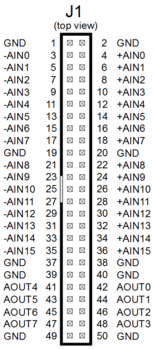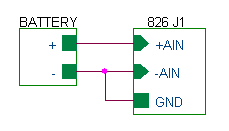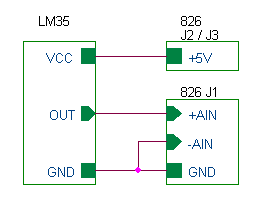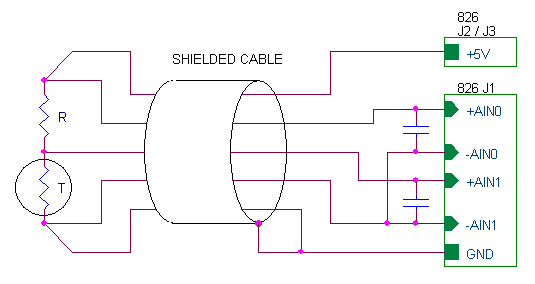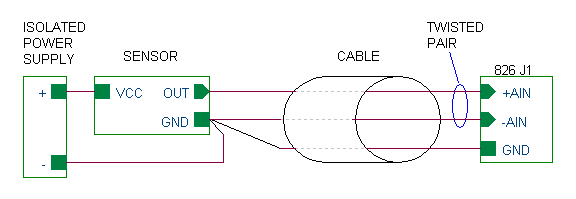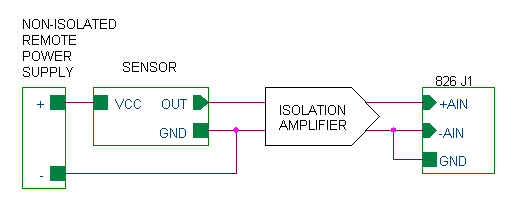826 ADC
This page contains application notes and other information about the Model 826 analog input system.
For other 826-related topics, please go to the top-level 826 page.
Contents |
Connector pinout
- Pin functions
-
+AINxand-AINx— differential analog signal pair for analog input channel x. These must both be connected to the voltage to be measured (like the leads of a voltmeter). -
AOUTx— single-ended output signal for analog output channel x (referenced toGND). -
GND— analog ground reference. This is internally connected to the computer's power supply return.
Connections
IMPORTANT: The board's analog input (AIN) pins are not isolated.
The AIN common mode voltage (CMV) is referenced to the GND pins on connector J1, which are internally connected to the PCIe power supply return. The voltage applied to an +AIN or -AIN pin must not exceed the absolute maximum CMV (see AIN specifications for CMV range). Use an isolation amplifier, level translator, or voltage divider to avoid directly connecting signals that exceed the allowed CMV range.
Measuring isolated sources
Measurement accuracy can be significantly degraded if AIN is connected to an unreferenced voltage source such as a battery or isolated power supply, or to a sensor powered by such sources. In such cases, since the source is isolated, AIN has no current return to GND, and consequently the input signal may be pulled (by protection circuitry) beyond the maximum allowed CMV. The resulting measurement errors can manifest in various ways (e.g., apparent non-linearity or calibration error) and can be difficult to characterize.
When measuring an unreferenced signal, the signal and its reference ground are effectively a differential pair. To provide a return path to GND, connect one side of the source to GND. This connection may be made to either the positive or negative terminal of the source pair.Anti-aliasing
The 826 analog input system employs a multiplexed successive-approximation ADC to facilitate high speed acquisition of switched inputs. Anti-alias filters are intentionally omitted to allow the highest possible performance in a wide range of applications. Consequently, to avoid aliasing, you must sample each analog input (differential pair) frequently enough to satisfy Nyquist. If, due to high signal frequencies, this isn't possible for a particular input, it is recommended to use an external anti-alias filter to attenuate high-frequency components and thus satisfy Nyquist. Depending on the application, this may be as simple as adding an RC filter across the differential input pair.
Measuring single-ended signals
- How do I connect a single-ended ±10 V signal which is referenced to ground?
This depends on the relationship between signal ground (measured near the signal source) and PC ground (available on 826 connector J1). These are the possible cases and their solutions:
- Signal ground = PC ground (because they are externally connected). In this case you can treat the signal and signal ground as a differential pair: connect the signal to +AIN and signal ground to -AIN. There is no need to connect to PC ground, and doing so might create a ground loop.
- Signal ground ≠ PC ground:
- Signal ground is isolated from PC ground (e.g., sensor is powered by an isolated supply) and thus is "floating" with respect to PC ground. In this case connect as shown in Isolated sensors.
- Signal ground is not isolated from PC ground (i.e., there is a voltage difference between the grounds). In this case you must isolate the signal source. This can be done by powering it from an isolated supply as shown in Isolated sensors or by using an isolation amplifier as shown in Mitigating high CMV.
Application examples
Floating source
When measuring an unreferenced voltage source such as a battery or isolated power supply, or a sensor powered by such sources, connect the signal ground to GND to avoid high CMV. GND may be connected to either +AIN or -AIN.
IC temperature sensor
This circuit uses an LM35 integrated circuit to measure temperature. +5V is routed from the J2 or J3 connector, and GND from the J1 connector, to power the IC. GND is also connected to -AIN because it is the ground reference for the sensor output. The LM35 output voltage is 10 mV/°C, which gives a measurement resolution of better than 0.002 °C on the ±1V measurement range.
Potentiometer position detector
In this circuit, the potentiometer wiper position can be determined by measuring the wiper voltage. Use a linear taper pot to get consistent measurement resolution over the full operating range. For improved accuracy, use a second AIN channel to measure the 5V excitation voltage (as in the thermistor example below).
Precision thermistor measurement
Two AIN channels are used in this circuit, one to measure thermistor voltage (AIN1) and another to measure the 5 V excitation (AIN0). This allows the software to compensate for excitation variations, which is done by computing the ratio of AIN1/AIN0 and then converting the ratio to temperature units. The cable shield should only be terminated at one end, to avoid ground loops. Choose R to obtain the desired measurement resolution.
Isolated sensors
Sensors which are powered by batteries and isolated power supplies can be directly connected to AIN. Connect 826 GND to sensor GND to avoid high CMV. For best performance and accuracy, sense GND at the sensor (by running a dedicated wire from sensor GND to -AIN), and use a twisted pair to reduce common mode noise.
Mitigating high CMV
In cases where the CMV would exceed the AIN absolute maximum rating, an isolation amplifier can be used to eliminate the excessive CMV.
Programming
Programming basics
In a typical application you will initialize the ADC system once and start it running, and then repeatedly read and process ADC sample data as required.
Initialize the ADC system
- 1. Assign slots
Each analog measurement requires one timeslot (a "slot"). There are 16 slots (numbered 0 to 15), so you can perform up to 16 measurements in a conversion burst.
Start by assigning a slot number to each measurement. It's not required to use all slots, and it's permissible to leave gaps between used slots. For example, you could use only slots 0, 5 and 11 if desired, although it's usually simpler to just use consecutive slots.
Note that this first step doesn't actually involve programming -- it's all about planning which slots to use and, for each slot, what to measure.
- 2. Configure slots
For every slot you assigned, call S826_AdcSlotConfigWrite to configure the slot for the desired analog input channel (AIN), input range and settling time.
IMPORTANT:
You must call S826_AdcSlotConfigWrite once for each slot you are using. Unconfigured slots will measure AIN0 by default.
Each slot can be used to measure any input channel. For example, the following will configure slot 0 to measure AIN13 using the ±10 V range, with 30 µs delay between input switching and start of conversion:
S826_AdcSlotConfigWrite(board, 0, 13, 30, S826_ADC_GAIN_1); // slot 0: measure AIN13 on ±10V range; tsettle = 30µs
Note: It's not necessary to configure slots that will not be used.
- 3. Enable slots
Call S826_AdcSlotlistWrite to enable all of the slots you are using. The second argument is a set of flags in which each bit is associated with a particular slot (bit 0 = slot 0, bit 1 = slot 1, etc.): '1' enables the slot and '0' disables it. For example, if you are only using slot 0 (e.g., as shown above, to measure AIN13):
S826_AdcSlotlistWrite(board, 0x0001, S826_BITWRITE); // enable only slot 0
If instead you were using slots 0, 1 and 15, you would do this:
S826_AdcSlotlistWrite(board, 0x8003, S826_BITWRITE); // enable slots 0, 1 and 15
Or if using all slots, do this:
S826_AdcSlotlistWrite(board, 0xFFFF, S826_BITWRITE); // enable all slots (0 to 15)
Note: You can call S826_AdcSlotlistWrite while the ADC is running to dynamically enable/disable particular slots.
- 4. Select trigger mode.
Use Continuous Mode if you want conversions to run automatically:
S826_AdcTrigModeWrite(board, 0); // trigger mode = continuous
Alternatively, you should use Triggered Mode if you want a counter or external signal to initiate conversions. This example shows how to use a counter to invoke periodic conversions.
- 5. Start ADC conversions
S826_AdcEnableWrite(board, 1); // enable adc conversions
The ADC is now allowed to perform conversions. In Continuous Mode it will continuously perform back-to-back conversion bursts; in Triggered Mode it will perform a conversion burst each time it's triggered. In each burst, the system will acquire data from all active slots.
- Summary
Putting it all together, your initialization code will look something like this:
// configure slots; in this example we use slots 0, 1 and 15 S826_AdcSlotConfigWrite(board, 0, 13, 30, S826_ADC_GAIN_1); // slot 0: measure AIN13 on ±10V range; tsettle = 30µs S826_AdcSlotConfigWrite(board, 1, 14, 40, S826_ADC_GAIN_2); // slot 1: measure AIN14 on ±5V range; tsettle = 40µs S826_AdcSlotConfigWrite(board, 15, 15, 30, S826_ADC_GAIN_1); // slot 15: measure AIN15 on ±10V range; tsettle = 30µs // do other init S826_AdcSlotlistWrite(board, 0x8003, S826_BITWRITE); // enable slots 0, 1 and 15 S826_AdcTrigModeWrite(board, 0); // trigger mode = continuous S826_AdcEnableWrite(board, 1); // start adc conversions
Read ADC data
You can read ADC data after the ADC system has been initialized and started. Call S826_AdcRead to receive ADC samples. Note that within each sample, the 16-bit signed binary ADC data is the least-significant 16 bits:
Consequently, you must extract the low 16-bits from each sample to get the ADC data value. For example, to read ADC data from slot 0:
int samples[16]; // adc samples -- Note: buffer must always be sized for 16 slots
uint slotlist = 0x0001; // read slot 0
S826_AdcRead(0, samples, NULL, &slotlist, S826_WAIT_INFINITE); // get slot 0 sample
printf("Binary adc data = %d", (short)(samples[0] & 0xFFFF)); // extract 16-bit adc data and display it
Or you could do this to read all slots:
int samples[16]; // adc samples
uint slotlist = 0xFFFF; // read all slots
S826_AdcRead(0, samples, NULL, &slotlist, S826_WAIT_INFINITE); // get adc data
for (int i = 0; i < 16; i++)
printf("AIN%d binary adc data = %d"\n, i, (short)(samples[i] & 0xFFFF));
Converting ADC data to volts
This function converts an ADC sample to volts:
double GetAdcVolts(int sample, uint range)
{
short adcdata = (short)(sample & 0xFFFF); // extract binary adc data from sample
double frac = adcdata * (1.0 / 0x7FFF);
switch (range) {
case S826_ADC_GAIN_10: return frac; break; // -1V to +1V
case S826_ADC_GAIN_5: return frac * 2.0; break; // -2V to +2V
case S826_ADC_GAIN_2: return frac * 5.0; break; // -5V to +5V
case S826_ADC_GAIN_1: return frac * 10.0; break; // -10V to +10V
default: return 0.0; break; // illegal range
}
}
Example usage:
int samples[16]; // adc sample buffer
uint slotlist = 0x0001; // only slot 0 is used in this example
S826_AdcRead(0, samples, NULL, &slotlist, S826_WAIT_INFINITE); // acquire sample
printf("ADC measured %f volts", GetAdcVolts(samples[0], S826_ADC_GAIN_1));
Handling ADC interrupts
An interrupt request (IRQ) is generated when the ADC completes a conversion burst. These IRQs are managed by the blocking function S826_AdcRead, which configures ADC interrupts and handles the resulting IRQs as required. To wait for the next IRQ, simply call S826_AdcRead; the function will return when ADC data is available, and will block and allow other threads to run while ADC data is unavailable.
The following example shows how this works. In this example, only slot 0 is being used, and timestamps are not used. Note that the ADC (and its trigger source) must have been previously configured and enabled (see next example).
void AdcHandler(void)
{
int errcode;
int adcdata[16]; // buffer must be sized for 16 slots
while (1) {
uint slotlist = 1; // only slot 0 is of interest in this example
errcode = S826_AdcRead(0, adcdata, NULL, &slotlist, S826_WAIT_INFINITE); // wait for IRQ
if (errcode != S826_ERR_OK)
break;
printf("Raw adc data = %d", adcdata[0] & 0xFFFF);
}
}
Periodic ADC conversions (self-paced)
- Can the ADC periodically acquire samples without using a counter to pace it?
Yes: To do this, configure the ADC for continuous triggering mode and use the slot settling times to control the sampling rate. Note that the sampling period will have a small amount of jitter (≤ 1 µs) because ADC conversion time is 2-3 µs. This example shows how to acquire approximately 20 samples per second from analog input 0:
#define SAMPLING_PERIOD 50000 // Sampling period in microseconds (50000 = 20 samples/s).
#define TSETTLE SAMPLING_PERIOD - 3; // Compensate for nominal ADC conversion time.
// Configure the ADC subsystem and start it running
S826_AdcSlotConfigWrite(board, 0, 0, TSETTLE, S826_ADC_GAIN_1); // measuring ain 0 on slot 0
S826_AdcSlotlistWrite(board, 1, S826_BITWRITE); // enable slot 0
S826_AdcTrigModeWrite(board, 0); // trigger mode = continuous
S826_AdcEnableWrite(board, 1); // start adc conversions
while (1) {
AdcHandler(); // Handle periodic ADC interrupts (using code from earlier example)
}
Periodic ADC conversions (using counter)
A counter can be used to periodically trigger ADC bursts. To do this, configure the counter as a periodic timer that outputs a pulse at the end of each period. The output pulse need not be routed to a DIO pin because the board can internally route it directly to the ADC's trigger input. Also, it's not necessary to generate counter snapshots because the ADC will notify software when a conversion burst has completed.
The following code shows how to digitize all 16 analog inputs in a burst, at a rate of period µs/burst. The bursts are triggered by counter0.
// Use counter0 to periodically trigger ADC conversions -------------
void StartAdc16(uint period) // Configure/start ADC and trigger generator
{
int i;
for (i = 0; i < 16; i++) // Configure all timeslots: 1 slot per AIN; 20µs/slot settling time.
S826_AdcSlotConfigWrite(0, i, i, 20, S826_ADC_GAIN_1);
S826_AdcSlotlistWrite(0, 0xFFFF, S826_BITWRITE); // Enable all 16 timeslots.
S826_AdcTrigModeWrite(0, 0xB0); // Hardware triggered, source = counter0 ExtOut.
S826_AdcEnableWrite(0, 1); // Enable ADC conversions.
CreateHwTimer(0, 0, period); // Create and start the trigger generator.
}
int ReadAdc16(int *adcbuf)
{
uint slotlist = 0xFFFF; // Wait for ADC burst completion.
return S826_AdcRead(0, adcbuf, NULL, &slotlist, S826_WAIT_INFINITE);
}
In the following example, all 16 AINs are digitized and processed ten times per second.
int adcbuf[16]; // sample buffer -- always set size=16 (even if fewer samples needed)
StartAdc16(100000); // Configure adc; start adc and trigger generator (trig every 100K us).
while (ReadAdc16(adcbuf) == S826_ERR_OK) { // Repeat forever:
// TODO: PROCESS ADC SAMPLES
}
Oversampling
Oversampling is a useful technique for reducing noise or increasing resolution. Model 826 facilitates oversampling by allowing an analog input (AIN) to be measured multiple times in a single ADC burst. After the burst, the samples can be averaged to obtain an enhanced sample value.
- Example
The following code shows how to oversample two AINs. In each burst, AIN0 is digitized eight times and then AIN1 is digitized eight times. To set this up, each AIN is assigned to eight contiguous slots. For each AIN, the first slot includes a settling time because the ADC input has just switched. The seven subsequent slots do not require settling time (and thus settling times are set to 0 µs) because the input has not switched.
The ADC's internal timing is used to pace conversions, by selecting the continuous triggering mode and assigning appropriate settling times. Slot 0 is assigned a long settling time, which effectively determines the sampling period and also provides a necessary settling delay. Slot 8 has a shorter settling time because it only needs to delay long enough for signal settling.
Note that error checking has been omitted here for clarity, but should always be included in robust application code.
// Settling times in microseconds
#define TSETTLE0 10000 // Delay after switching to AIN0 (tweak this to adjust sampling rate).
#define TSETTLE1 20 // Delay after switching ADC to AIN1.
// Average 8 samples and convert to volts (assumes +/-10V measurement range)
#define VOLTS(SUM) ((SUM) * 10.0 / (8.0 * 32768.0))
int slot;
int adcbuf[16]; // Sample buffer -- always set size=16 (even if fewer samples needed)
// Adc timeslot attributes.
struct SLOTATTR {
uint chan; // analog input channel
uint tsettle; // settling time in microseconds
} attr[16] = { // During each burst:
{0, TSETTLE0}, // switch to AIN0, delay, then digitize
{0, 0}, {0, 0}, {0, 0}, {0, 0}, {0, 0}, {0, 0}, {0, 0}, // digitize AIN0 7 more times without delay
{1, TSETTLE1}, // switch to AIN1, delay, then digitize
{1, 0}, {1, 0}, {1, 0}, {1, 0}, {1, 0}, {1, 0}, {1, 0}}; // digitize AIN1 7 more times without delay
// Configure all 16 timeslots.
for (slot = 0; slot < 16; slot++)
S826_AdcSlotConfigWrite(board, slot, attr[slot].chan, attr[slot].tsettle, S826_ADC_GAIN_1);
// Configure adc system and start it running.
S826_AdcSlotlistWrite(board, 0xFFFF, S826_BITWRITE); // Enable all 16 timeslots.
S826_AdcTrigModeWrite(board, 0); // Select continuous triggering mode.
S826_AdcEnableWrite(board, 1); // Start conversions.
while (1) // Repeatedly fetch and display oversampled data:
{
int sum[] = {0, 0}; // Reset sample accumulators (one per AIN).
uint slotlist = 0xFFFF; // Wait for ADC burst
S826_AdcRead(board, adcbuf, NULL, &slotlist, 1000); // and read samples from 16 slots.
for (slot = 0; slot < 16; slot++) // Sum the 8 samples from each AIN
sum[slot >> 3] += (short)(adcbuf[slot] & 0xFFFF); // while masking off sample meta-data.
// Compute and report measured voltages.
printf("AIN0=%3.3fV, AIN1=%3.3fV\n", VOLTS(sum[0]), VOLTS(sum[1]));
}
Polled operation
- How can I read analog inputs as fast as possible?
In event-driven applications, the S826_AdcRead function is allowed to block until ADC samples are available. However, blocking necessarily involves context switching, which introduces overhead. To avoid this overhead, blocking must be disabled. This is done by setting argument tmax=0, which allows the ADC subsystem to be polled without blocking.
- Example
The following code employs polling to acquire data from all 16 AINs. Each call to S826_AdcRead will return immediately, with slotlist bits indicating the AINs that have new samples waiting in adcbuf. If desired, individual samples may be processed when they arrive in adcbuf (each time S826_AdcRead executes), or the program can wait for all 16 AINs and then process them en masse.
In this example a 7 µs settling delay is allowed before each conversion begins. The ADC conversion time is ≤3 µs, so the total time per AIN is ≤10 µs and the burst time for all AINs is ≤160 µs. Note that individual settling times may need adjustment depending on factors such as source impedance and required accuracy.
#define TSETTLE 7 // Settling delay after switching AIN (adjust as necessary).
#define SLOTFLAGS 0xFFFF // Timeslot flags: use all 16 timeslots.
int i;
int adcbuf[16]; // Sample buffer -- always set size=16 (even if fewer samples needed)
// Configure all timeslots: 1 slot per AIN; constant settling time for all slots.
for (i = 0; i < 16; i++)
S826_AdcSlotConfigWrite(board, i, i, TSETTLE, S826_ADC_GAIN_1);
// Configure adc system and start it running.
S826_AdcSlotlistWrite(board, SLOTFLAGS, S826_BITWRITE); // Enable all 16 timeslots.
S826_AdcTrigModeWrite(board, 0); // Select free-running mode.
S826_AdcEnableWrite(board, 1); // Start conversions.
while (1) // Repeat forever:
{
uint remaining = SLOTFLAGS; // timeslots that have not yet been read
do {
uint slotlist = remaining; // Read all available remaining timeslots.
int errcode = S826_AdcRead(board, adcbuf, NULL, &slotlist, 0); // note: tmax=0
remaining &= ~slotlist;
// OPTIONAL: NEWLY ARRIVED SAMPLES MAY BE PROCESSED WHILE WAITING FOR REMAINING SAMPLES
} while (errcode == S826_ERR_NOTREADY);
if (errcode != S826_ERR_OK)
break; // error
// TODO: PROCESS ALL UNPROCESSED SAMPLES IN ADCBUF
}
Software triggering
Some applications require that ADC conversion bursts be triggered by software. To set this up, configure the ADC for hardware-triggering and select one of the board's virtual digital outputs as the trigger source. The software can then write to the virtual digital output to start an ADC conversion burst. The following code shows how to use virtual digital output 0 as a software-controlled ADC trigger:
#define TSETTLE 7 // Settling delay after switching AIN (in microseconds; adjust as necessary).
#define SLOTFLAGS 0xFFFF // Timeslot flags: use all 16 timeslots.
#define VIRTOUT 0 // Use virtual digital output 0 as ADC burst trigger.
void InitAdc(uint board)
{
// Configure all timeslots: 1 slot per AIN; constant settling time for all slots.
int i;
for (i = 0; i < 16; i++)
S826_AdcSlotConfigWrite(board, i, i, TSETTLE, S826_ADC_GAIN_1);
// Configure adc system and start it running.
S826_AdcSlotlistWrite(board, SLOTFLAGS, S826_BITWRITE); // Enable all 16 timeslots.
S826_AdcTrigModeWrite(board, VIRTOUT + 182); // Use virtual digital output as trigger.
S826_AdcEnableWrite(board, 1); // Enable conversions.
}
This triggers a conversion burst:
void TriggerBurst(uint board)
{
S826_VirtualWrite(board, 1 << VIRTOUT, S826_BITSET); // Rising edge of trigger starts conversion.
S826_VirtualWrite(board, 1 << VIRTOUT, S826_BITCLR); // Falling edge of trigger pulse.
}
This returns True if a conversion burst has completed:
int IsBurstDone(uint board)
{
uint status;
S826_StatusRead(board, &status);
return (status == SLOTFLAGS);
}
This example demonstrates how to use the above code:
InitAdc(0);
while (1) // Repeat forever:
{
uint slotlist;
int slot;
int adcbuf[16]; // Sample buffer -- always set size=16 (even if fewer samples needed)
TriggerBurst(0); // Trigger a conversion burst.
do {} while (!IsBurstDone(0)); // Poll until burst completes.
slotlist = SLOTFLAGS; // Copy ADC data into adcbuf.
int errcode = S826_AdcRead(0, adcbuf, NULL, &slotlist, 0); // note: tmax=0
for (slot = 0; slot < 16; slot++) // Display all samples.
printf("Slot %d sample value = %d\n", slot, adcbuf[slot]);
}
Other
Calibration errors caused by missing shunt
On 826 SDKs earlier than version 3.2.0, analog calibration values will not be applied without J6 (labeled "Calibration Enable") installed. A missing shunt is intended to protect against accidental overwriting of calibration values, but in these SDKs it also prevents the reading of those values. This is resolved in SDK version 3.2.0 and above; in these versions the shunt functions as intended and must be installed only when calibrating the board (though leaving it installed all the time is okay).
If board calibration is incorrect, make sure J6 is installed or upgrade to SDK version 3.2.0 or higher. The 826 SDK can be downloaded from the 826 product page.
ADC transfer functions
Each ADC input voltage range extends slightly beyond the negative end of its indicated range:
| Range: | ±10V | ±5V | ±2V | ±1V |
|---|---|---|---|---|
| ADC data | Input voltage (V) | |||
| 0x7FFF | +10.0 | +5.0 | +2.0 | +1.0 |
| 0x0000 | 0.0 | 0.0 | 0.0 | 0.0 |
| 0x8001 | -10.0 | -5.0 | -2.0 | -1.0 |
| 0x8000 | -10.0003 | -5.00015 | -2.00006 | -1.00003 |
ADC accuracy specification
Resolution and no missing codes are both 16 bits minimum.
| Parameter | Value | Units | Description | ||
|---|---|---|---|---|---|
| Min | Typ | Max | |||
| Integral Nonlinearity Error | ±0.75 | ±1.5 | LSB | Deviation of ADC transfer function from best-fit line | |
| Differential Nonlinearity Error | ±0.5 | ±1.25 | LSB | Deviation of ADC code width from ideal code width | |
| Gain Error | ±2 | ±40 | LSB | Deviation of difference between actual level of last data transition and actual level of first transition from difference between ideal levels | |
| Gain Error Temperature Drift | ±0.3 | ppm/°C | |||
| Zero Error | ±0.8 | mV | Difference between ideal midscale voltage and actual voltage producing the midscale output code | ||
| Zero Temperature Drift | ±0.3 | ppm/°C | |||
Maximum input voltage
The analog inputs accept common mode voltages (CMV) up to ±12V with no resulting input current or damage. CMV up to ±25V is tolerated continuously, though this will cause currents to flow in the analog inputs. CMV greater than 25V may be tolerated for brief intervals, but this can cause significant currents to flow in the analog inputs and is not specified nor guaranteed to be safe.
IMPORTANT: Analog inputs are not isolated
The input CMV is referenced to the GND signal on connector J1, which is internally connected to the PCIe power supply return.
